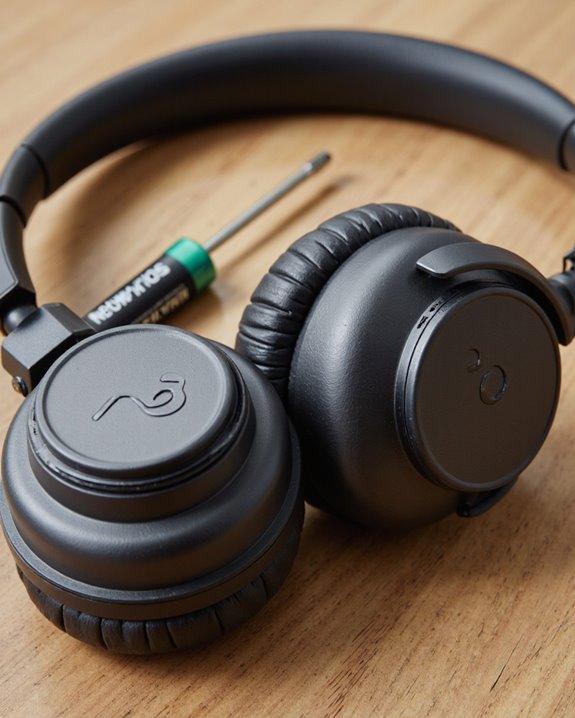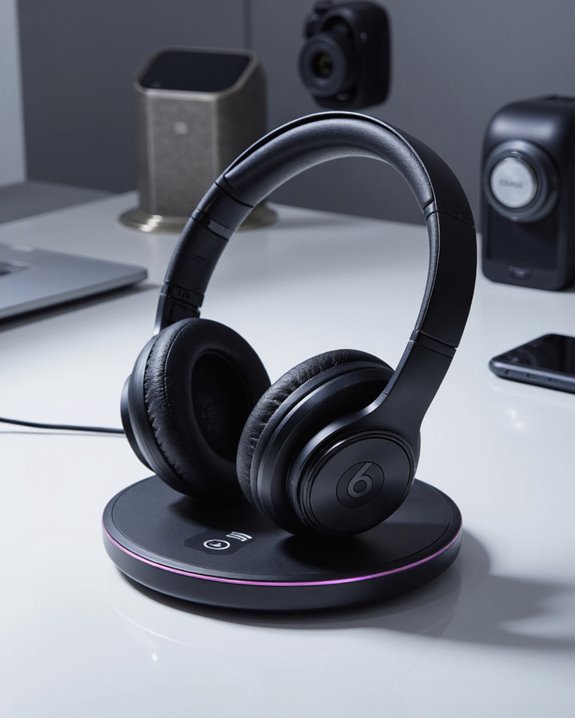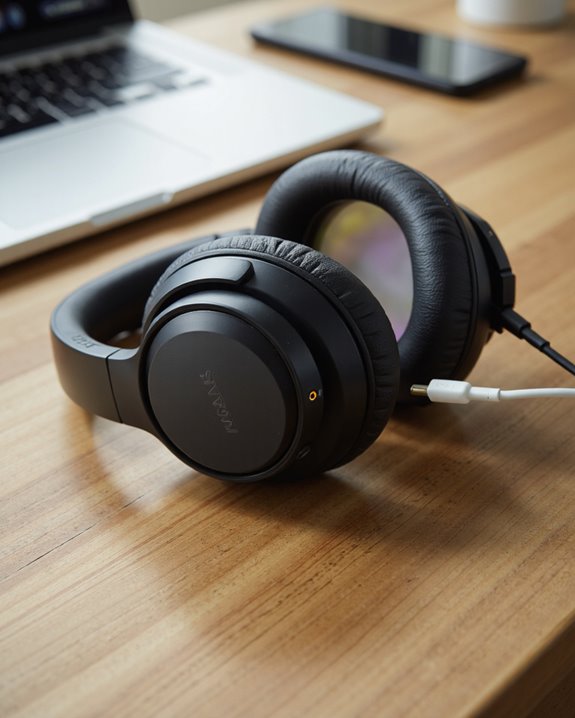As an Amazon Associate, we earn from qualifying purchases. Some links may be affiliate links at no extra cost to you. Although our opinions are based on curated research, we haven't used these products. Articles generated with AI.
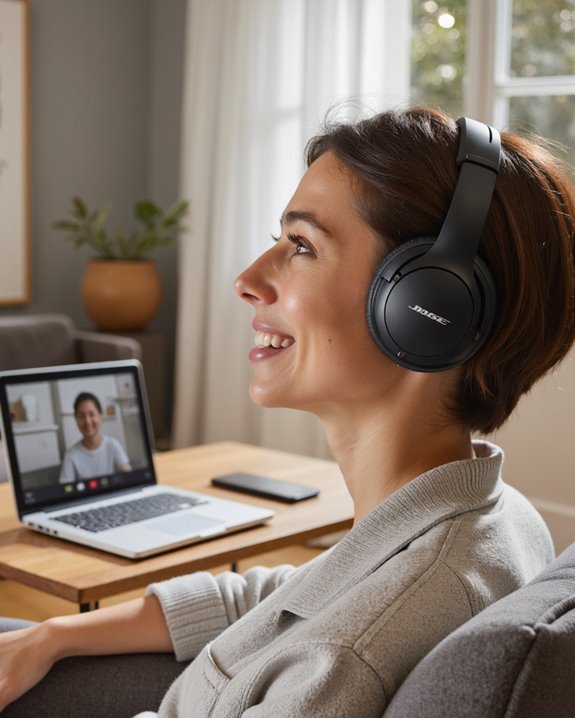
Can You Talk Through Bose Headphones?
Yes, we can talk through Bose headphones using their integrated multi-microphone arrays, which are engineered to capture our voices clearly while suppressing background noise via advanced noise cancellation and adaptive audio algorithms. Whether we’re connected over Bluetooth® or using a wired setup, selecting Bose as the primary input and output in our device settings guarantees reliable, crisp communication. Regular firmware updates and proper setup further optimize performance. Explore how setup details and connection choices can refine your call quality even more.
Key Takeaways
- Yes, Bose headphones include built-in microphones that allow you to talk during calls or voice chats.
- Both Bluetooth® and wired connections support using the headphones’ microphone for conversations.
- Advanced noise cancellation and adaptive microphones help filter out background noise for clearer speech.
- You must select your Bose headphones as the input device in your computer or phone’s audio settings.
- Regular firmware updates via the Bose Connect app help maintain optimal microphone performance and compatibility.
Understanding Microphone Capabilities in Bose Headphones
When we look at the microphone capabilities in Bose headphones, it’s clear that the company has prioritized both clarity and versatility across its product lines. Bose’s microphone design integrates multiple mics—often with arrays of two to four microphones—strategically placed to capture the user’s voice while minimizing ambient interference. Advanced noise cancellation technology plays a vital role, actively filtering out background noise during calls or voice commands. For instance, the Bose QuietComfort series employs adaptive algorithms that distinguish speech from environmental sounds, ensuring voices are transmitted with minimal distortion. Additionally, features like “Aware Mode” allow us to hear nearby sounds without sacrificing microphone performance. These integrated solutions make Bose headphones suitable for both professional and casual use, offering reliable voice clarity in diverse environments.
Setting Up Your Headphones for Voice Communication
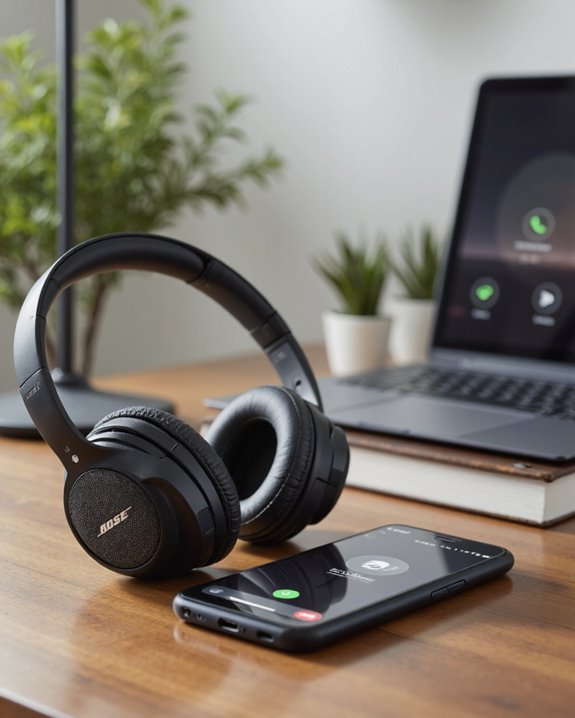
Setting up Bose headphones for voice communication involves more than simply pairing them with your device; it requires attention to both hardware compatibility and software configuration. First, let’s confirm headphone compatibility—models like the Bose QuietComfort and Noise Cancelling Headphones series include a built-in microphone, essential for clear voice transmission. We’ll need to connect the headphones to our device, using either Bluetooth® or a wired connection, then select them as both input and output within our device’s audio settings. Microphone placement is maximized by Bose’s design, but we should still check and adjust microphone volume in the device’s settings. Testing the setup using voice or conferencing apps verifies functionality. Regular firmware updates via the Bose Connect app guarantee ongoing compatibility and ideal voice communication performance.
Troubleshooting Microphone Issues
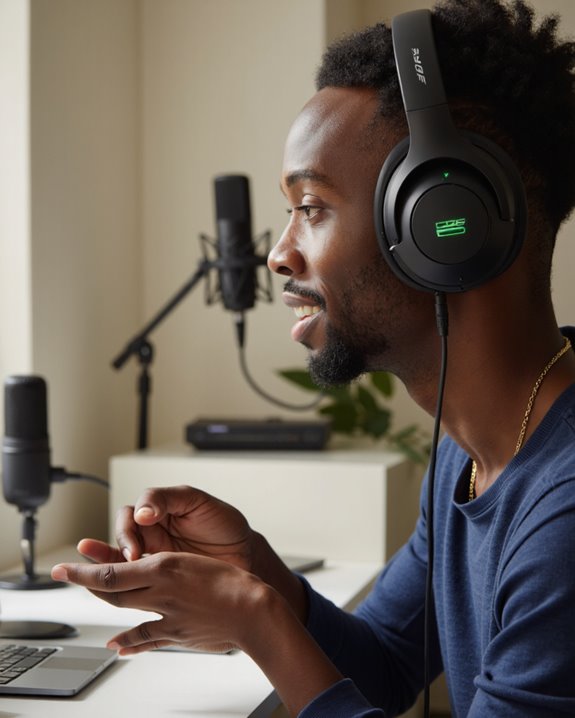
Although Bose headphones are designed for seamless voice communication, we may encounter situations where the microphone doesn’t function as expected during calls or recordings. First, let’s verify microphone sensitivity and connection stability. Confirm the headphones are securely paired or plugged into our device. Next, check device settings to validate microphone permissions are enabled for the apps we’re using. If the problem persists, restarting the device can often resolve temporary glitches affecting the microphone. It’s also important to inspect the headphone’s microphone area—make sure it’s unobstructed and free from dust or debris. Additionally, test the microphone in different applications to determine if the issue is app-specific. Finally, adjust the volume to a suitable level for peak voice capture and clarity during communication.
Optimizing Audio Settings for Clear Conversations

Once we’ve addressed common microphone issues, it’s time to fine-tune our Bose headphones’ audio settings to enhance clarity during conversations. For best audio clarity, we should confirm our headphones are correctly connected—either via Bluetooth® or a wired link—to guarantee stable audio transmission. On our device, selecting the Bose headphones as the primary input source in microphone settings prioritizes their advanced microphones for accurate voice capture. Using the Bose Connect app, we can adjust noise cancellation levels; increasing noise cancellation often improves conversation clarity by minimizing background distractions. It’s also wise to test our setup on various communication platforms, guaranteeing consistent performance. Finally, regularly updating the headphones’ firmware through the Bose Connect app assures compatibility and improved audio processing, keeping our conversations crisp and clear.
Common Connection Types and Their Impact

When evaluating how Bose headphones handle conversations, we need to reflect on the two primary connection types: Bluetooth® wireless and traditional wired.
Bluetooth performance introduces both convenience and potential challenges. While wireless freedom is appealing, Bluetooth® can introduce latency and audio compression, sometimes reducing voice clarity during calls. Users may also notice occasional connectivity issues or interference, particularly in environments with multiple wireless devices. Ensuring proper pairing and device compatibility is essential for ideal microphone functionality.
On the other hand, wired advantages are clear. A direct connection virtually eliminates latency and audio compression, providing a more consistent and reliable audio signal. This stability enhances both listening and speaking performance, making wired connections preferable for critical conversations or professional settings. Testing both methods across devices can help us determine the best connection for our needs.
Tips for Enhancing Call Quality With Bose Headphones
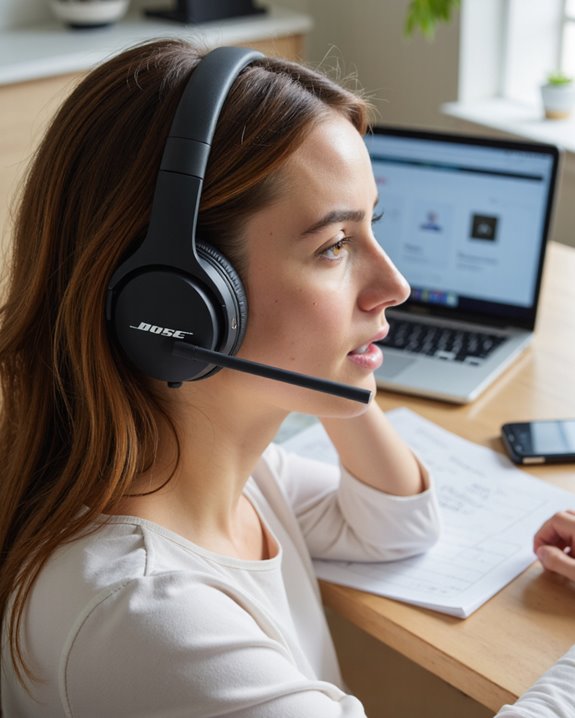
To maximize call clarity with Bose headphones, we need to focus on a combination of device setup, firmware maintenance, and ideal usage techniques. First, let’s verify our headphones are connected via a stable Bluetooth or wired link, as weak connections can degrade audio performance. Regular firmware updates are essential; they not only deliver new features but also resolve issues affecting call quality and sound isolation. Adjusting microphone settings on our device helps minimize background noise and boosts vocal clarity. Activating Bose’s noise-cancellation feature further enhances sound isolation, ensuring our voice remains clear regardless of environment. Finally, proper microphone positioning—speaking directly toward it—can make a marked difference in transmission precision. With these steps, we’ll consistently achieve superior call clarity during every conversation.
Frequently Asked Questions
Can You Use Bose Headphones for Calls?
Let’s explore whether we can use Bose headphones for calls. We find that call quality is impressive thanks to thoughtful microphone placement. We don’t have to worry about background noise, and hands-free controls make conversations effortless.
Are Bose Headphones Good for Talking?
When we’re talking, Bose headphones really stand out for their sound quality and noise cancellation. We’ve noticed conversations are clear and background noise is minimal, making them a great choice for calls or virtual meetings.
Why Can’t I Talk on the Phone With My Bose Headphones?
If we can’t talk on the phone with our Bose headphones, it’s often due to microphone issues or connectivity problems. Let’s check Bluetooth pairing, sound settings, app permissions, and make sure the headphones’ microphone isn’t damaged or muted.
Which Bose Headphones Have a Microphone?
Let’s explore which Bose headphone models truly include microphones. We’ll find many, like the QC35 II, 700, and SoundLink II, offer built-in mics with impressive microphone quality, ensuring clear calls and seamless voice assistant use.


